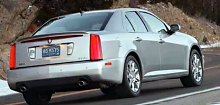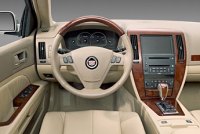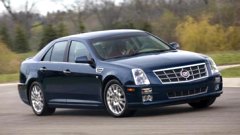|
Cadillac STS
Debut: 2004
Maker: General Motors
Predecessor: Cadillac Seville (1998)
|
|
 So
far, Cadillac's revival plan is going on quite well. The stream of new
cars like CTS, SRX and XLR are leagues above their predecessors in
terms
of engineering and desirability. But Roman was not built in one day. It
will take years of consistent performance to change the customers'
view,
so every new launch will be vital to Cadillac. This is especially true
to the new STS, Cadillac’s top luxurious car. So
far, Cadillac's revival plan is going on quite well. The stream of new
cars like CTS, SRX and XLR are leagues above their predecessors in
terms
of engineering and desirability. But Roman was not built in one day. It
will take years of consistent performance to change the customers'
view,
so every new launch will be vital to Cadillac. This is especially true
to the new STS, Cadillac’s top luxurious car.
We used to
call
it "Seville"
while the suffix STS was reserved for the sporting model of the Seville
range. Now to put it in line with other Cadillac models, Seville is
renamed
to simply STS. By coincidence or not, the new STS really emphasizes on
sporting character. The most obvious sign is the discard of the
front-drive
G-platform and opt for the rear-drive Sigma platform. This platform is
shared with CTS, SRX and the future Holden Commodore. Its chassis
rigidity
and fine handling has been demonstrated in the CTS already. In the
flagship
STS, the re-engineering concentrated on enlarging it to accommodate V8
power and a larger cabin and to improve noise insulation. A lot of
sound-deadening
materials, double glazing windows and triple-sealed doors are employed
to insulate the cabin from noise sources. As a result, the STS matches
European luxurious saloons for quietness.
 Like
other American cars, the STS offers a lot of metal and space for
relatively
little money. Price-wise, it competes with the high-end Mercedes
E-class.
Size-wise, it matches S-class in all dimensions. It measures just below
5 meters in length and has a 2957mm-long wheelbase. By tape measure,
the
interior head and leg-room are really close to a short-wheelbase
S-class,
but strangely, car testers did not find it as spacious. This might be
due
to the shape of the seats or the intrusive transmission tunnel. If you
look for limousine level of space, STS could be a disappointment. Like
other American cars, the STS offers a lot of metal and space for
relatively
little money. Price-wise, it competes with the high-end Mercedes
E-class.
Size-wise, it matches S-class in all dimensions. It measures just below
5 meters in length and has a 2957mm-long wheelbase. By tape measure,
the
interior head and leg-room are really close to a short-wheelbase
S-class,
but strangely, car testers did not find it as spacious. This might be
due
to the shape of the seats or the intrusive transmission tunnel. If you
look for limousine level of space, STS could be a disappointment.
The trimming
is not
completely
convincing either. American journalists praised it for real woods,
alloy
and leather, but isn't it every luxurious car should have these
materials?
compare with European offerings, the STS cabin looks rather bland and
lack
of elegance. Everything is big - big piece of dashboard molding, big
center
console, big instrument panel, big transmission tunnel…. a sharp
contrast
to the fine detailing approach of European cars.
The
same problem
is found
at the exterior design. To me, STS is not the best example of the "Art
and Science" styling theme - it works best in the concept car Imaj,
Cien
and Sixteen, all have radical shapes and sharp details. Unfortunately,
in the fear of losing loyal customers, Cadillac has softened the sharp
edges in STS and results in a rather compromised shape - it looks
neither
eye-catching nor elegant. More chromed details like the Sixteen could
bring
back the glorious feel of the pre-war Cadillac, but it did not do that.
Now the STS looks under-styled, under-detailed like Infiniti Q45.
Frankly
speaking, I prefer the styling of the outgoing Seville.
 The
Sigma is not the most sophisticated platform for a luxurious car. It
was
upgraded from a middle-size platform, unlike Mercedes / BMW / Audi /
Jaguar
/ Lexus etc. which develop a dedicated platform for their luxurious
cars.
Inevitably, there is some compromises in chassis and suspension design
for the lower price models. In place of its rivals' air suspensions,
the
Cadillac employs magnetic adaptive damping by Delphi, GM's component
division.
Theoretically, using electromagnetic field to alter viscosity of
damping
fluid, hence damping rate, is a clever idea. But the European and
Japanese
experts are not fools and they know what advantages and disadvantages
the
Magnetic Ride Control has. Drive a STS equipped with this optional
feature
and you will know - it limits body movement successfully, but it pays
the
price in ride quality. No matter in comfort or sport mode, the ride is
stiffer than a luxurious saloon ought to have. Undoubtedly, air
suspension
is still a better solution. The
Sigma is not the most sophisticated platform for a luxurious car. It
was
upgraded from a middle-size platform, unlike Mercedes / BMW / Audi /
Jaguar
/ Lexus etc. which develop a dedicated platform for their luxurious
cars.
Inevitably, there is some compromises in chassis and suspension design
for the lower price models. In place of its rivals' air suspensions,
the
Cadillac employs magnetic adaptive damping by Delphi, GM's component
division.
Theoretically, using electromagnetic field to alter viscosity of
damping
fluid, hence damping rate, is a clever idea. But the European and
Japanese
experts are not fools and they know what advantages and disadvantages
the
Magnetic Ride Control has. Drive a STS equipped with this optional
feature
and you will know - it limits body movement successfully, but it pays
the
price in ride quality. No matter in comfort or sport mode, the ride is
stiffer than a luxurious saloon ought to have. Undoubtedly, air
suspension
is still a better solution.
However, if
you
could put
up with the un-luxurious-car-like ride, you are likely to appreciate
the
sporty character of the STS. Its all-aluminum, 4.6-liter 32-valve
Northstar
V8 has been serving the Seville since 2 generations ago. Now added with
continuous variable valve timing at all 4 camshafts, it generates 320
horsepower
and 315 lbft of torque. But its basic character is unchanged - strong,
eager and sounds great to ears. Not as refined or frugal as some
rivals,
but that is hardly a concern to the STS drivers. What they care more is
how quick the car accelerate - it takes just 6 seconds flat to 60mph,
beating
all other rivals. Another engine, a 255hp 3.6-litre 24-valve V6 came
from
CTS (we have talked about it in that report), also provides remarkable
performance compare with its V6 rivals. Both engines use GM's 5-speed
automatic
to transmit power to the rear wheels. It would have been better to have
6 or 7-speed automatic like its rivals, but the GM unit shifts smoothly
and flawlessly such that it should not be a negative point.
 The
Sigma-based STS handles leagues better than the outgoing Seville. We
used
to criticize the torque steer of Seville - it was the world's most
powerful
front-wheel drive car. The new car is totally different. By letting the
rear wheels to do the job of transmitting power, the front wheels
concentrate
on changing direction, the STS finally matches European rivals for
handling.
Its chassis is neutrally balanced. Body roll is limited by the firm
suspensions.
Strong grip enables high cornering speed. It is quite a surprise to see
such a big improvement in handling, albeit in the price of ride
comfort.
The only disappointment is the lack of steering feel. It is accurate
and
weighty enough, but feedback nothing from the front wheels. This
prevent
it from really matching BMW 7-series, Audi A8, Mercedes S-class and
Jaguar
XJ in driver appeal. The
Sigma-based STS handles leagues better than the outgoing Seville. We
used
to criticize the torque steer of Seville - it was the world's most
powerful
front-wheel drive car. The new car is totally different. By letting the
rear wheels to do the job of transmitting power, the front wheels
concentrate
on changing direction, the STS finally matches European rivals for
handling.
Its chassis is neutrally balanced. Body roll is limited by the firm
suspensions.
Strong grip enables high cornering speed. It is quite a surprise to see
such a big improvement in handling, albeit in the price of ride
comfort.
The only disappointment is the lack of steering feel. It is accurate
and
weighty enough, but feedback nothing from the front wheels. This
prevent
it from really matching BMW 7-series, Audi A8, Mercedes S-class and
Jaguar
XJ in driver appeal.
The change of
character in
STS shows exactly the path Cadillac is going. Obviously, it has chosen
the same route as BMW rather than Lexus. In some ways it is even more
hardcore
than BMW, daring to sacrifice comfort for better handling. It has quite
a few flaws though. A glorious design and some fine tuning to the
suspensions
and steering will solve most problems. Before then, it can be only seen
as an alternative choice to the various excellent cars in luxurious
segment. |
| The
above report was last updated on 4 Aug 2004. All
Rights Reserved. |
STS-V
|
 After
the Corvette-engined CTS-V, I almost thought the flagship STS-V would
be powered by the mighty LS7 V8 from the new Corvette Z06. Luckily,
Cadillac understood that STS-V needs not only power but also luxury-car
refinement to justify its US$75,000 asking price. Therefore it decided
to start from the Northstar V8. After
the Corvette-engined CTS-V, I almost thought the flagship STS-V would
be powered by the mighty LS7 V8 from the new Corvette Z06. Luckily,
Cadillac understood that STS-V needs not only power but also luxury-car
refinement to justify its US$75,000 asking price. Therefore it decided
to start from the Northstar V8.
The all-aluminum V8 retains its sophisticated valve gears - quad-cam,
32 valves and dual continuous VVT. To prepare for the increased
internal stress and heat, it has its cylinder walls thickened. That
reduced engine capacity to 4371cc. Then, an Eaton Roots-type
supercharger was bolted onto the V-valley together with its integral
air-to-water intercooler. It raises max power to 469 ponies at 6400 rpm
and max torque to 439 lbft at 3800 rpm. That's more than Audi S6 and
S8, not far behind BMW M5 and Mercedes CLS55 / E55 AMG. A respectable
specific output 107 hp per litre actually beats the supercharged AMG.
The supercharged engine transmits its power to an upgraded automatic
gearbox with 6 forward gears and manual control.
The power delivery is much more refined than the Corvette-engined CTS-V
yet provides plenty of low down torque to pull the 1950 kg machine. A
delicious exhaust note and lack of supercharger whine is a surprising
quality for an American engine. The automatic gearbox also shifts
smoothly, but its response is rather slow, no matter at auto or manual
mode.
In straight line, STS-V is not as quick as BMW M5 and Mercedes CLS55
AMG. For example, C&D magazine found them 0.4 seconds quicker to 60
mph and 1.6-2.0 seconds quicker to 100 mph. This is not a surprise, as
its rivals are smaller and significantly lighter. However, any big
luxury sedans capable of doing 0-60 under 5 seconds should be
respected, shouldn't they?
Like its little sister, STS-V has been tested extensively in the USA as
well as Germany's Nurburgring ring, on which 8:31 was recorded. This
resulted in a lot of chassis improvements, such as pizza-size Brembo
disc brakes, quick steering ratio, a front suspension tower bar and the
engine mounted 0.5-inch lower than the
regular car. Nevertheless, the suspensions are set only 15% stiffer
than the standard STS in order to preserve a good ride quality.
On the road, the STS-V is not as keen a driver's car as M5 and CLS55.
Although steering feedback is spot-on, the whole car feels more softly
sprung and less tightly controlled than the German cars. More like
Jaguar S-Type R, it does not want to sacrifice ride comfort for
handling. A roomy cabin and automatic transmission support this
character.
The real problem is how many people will pay so much money to buy an
American car when there are more exciting offerings from European
prestige brands at roughly the same price. Cadillac needs 1,000-2,000
customers a year to justify the development costs. |
| The
above report was last updated on 15 Feb
2006. All Rights Reserved. |
2007 facelift
|
 Sales
of Cadillac's flagship STS has been slow. One of the reasons is that it
doesn't have the elegant design and build quality to match its European
and Lexus rivals. To make life easier, GM decided to give it an early
facelift in 2007. Outside, the STS gets a more prominent grille and
more chromed parts (e.g. door handles, door sill and boot lid lining)
to deliver an upmarket image, while fake air extractors have been added
to the front fenders to imply higher performance. Not much changes can
be found
in the cabin, but the driver should notice the adoption of
speed-sensitive variable ratio steering, which quickens the steering at
low speed and especially helpful to parking, and a Volvo-like blind
spot warning system, which lights up a warning icon located at the side
mirrors if something enter the blind spots. Sales
of Cadillac's flagship STS has been slow. One of the reasons is that it
doesn't have the elegant design and build quality to match its European
and Lexus rivals. To make life easier, GM decided to give it an early
facelift in 2007. Outside, the STS gets a more prominent grille and
more chromed parts (e.g. door handles, door sill and boot lid lining)
to deliver an upmarket image, while fake air extractors have been added
to the front fenders to imply higher performance. Not much changes can
be found
in the cabin, but the driver should notice the adoption of
speed-sensitive variable ratio steering, which quickens the steering at
low speed and especially helpful to parking, and a Volvo-like blind
spot warning system, which lights up a warning icon located at the side
mirrors if something enter the blind spots.
However, these minor modifications can hardly lure buyers from its
higher quality and more technological advanced rivals. Therefore this
time GM shifts its focus to the cheaper V6 model. The previous 255hp
3.6-liter DOHC V6 has been substantially upgraded to 302 horsepower,
thanks to the addition of direct injection which allows 11.3:1
compression. Now it is only 18 horses short of the Northstar V8, and
the car is around 100 kilograms lighter. Moreover, now the V6 gets the
same 6-speed automatic transmission as the V8, so performance should be
very close. We expect most sales will shift to the V6. It might also
steal some sales from the smaller Mercedes E-class, BMW 5-Series and
Lexus GS. |
| The
above report was last updated on 10 May
2007. All Rights Reserved. |
|
|